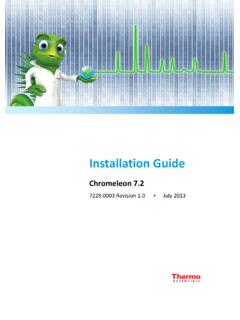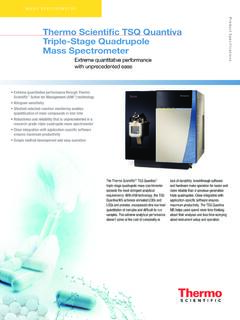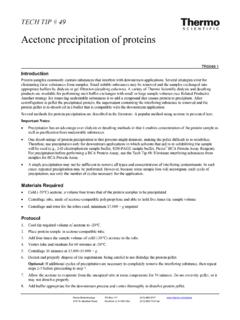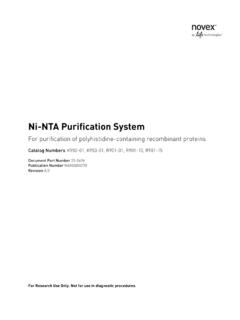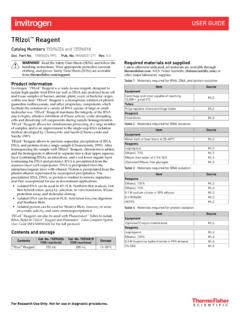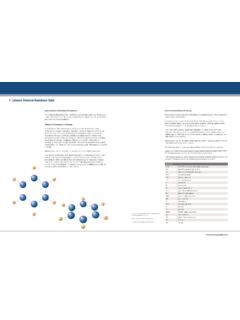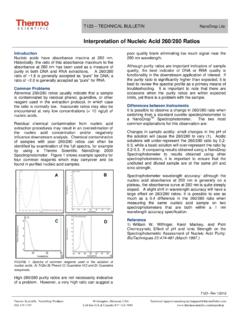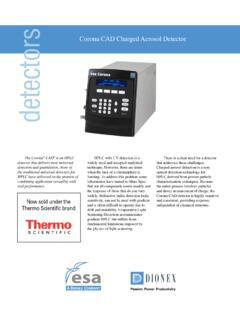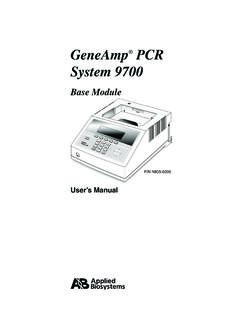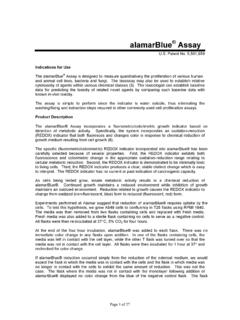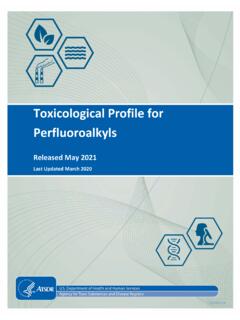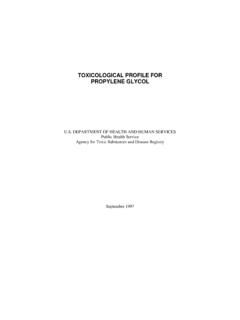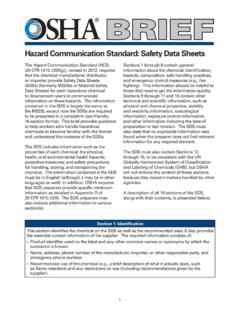Transcription of Extractables and leachables: Regulatory requirements for ...
1 Extractables and leachables: Regulatory requirements for vaccine and biologic products White PaperExtractables are chemical species that migrate from packaging or container materials into the contents when exposed to certain solvents under exaggerated temperature and time conditions. Leachables are chemical species that make their way into the product under normal application conditions. Extractables and leachables are important factors to consider as they have the potential to interact with a drug at multiple stages during development and production, which could impact efficacy, safety and quality. There is generally an overlap such that the leachables involved may be classified as a subset of the Extractables . However, if the leachable interacts with the drug product or packaging materials, new components can be present (Figure 1).
2 Based on the problems these factors can cause, their presence must be evaluated in those components which come into contact with the product during formulation, intermediate storage and final packaging for any sign of Extractables or leachables1. This not only enables a greater understanding of how to manage Extractables and leachables during development, but also assists with ensuring they fall within Regulatory requirements for container closure systems (CCS) and packaging WordsExtractables, leachables, polycyclic aromatic hydrocarbons, plastics, container-closure systems, pharmaceutical 1. The Food and Drug Administration (FDA) defines Extractables as compounds that can be extracted from the CCS when in the presence of a solvent, and leachables as compounds that leach into the drug product formulation from the container closure as a result of direct contact with the of drugs and biologic products are responsible for conducting any and all assessments for the detection of Extractables and leachables in a finished product.
3 For example, the European Medicines Agency (EMA) guidelines require packing material data from extraction studies, interaction studies (which include sorption and migration studies) as well as toxicological information and documentation2. However, often time and/or internal resources to conduct extensive chemical testing may be vendors of manufacturing and packaging components, including Thermo Fisher Scientific, provide customers with Extractables data. This information is used for preliminary screening and will require further studies to assess the risk to a particular product and/or process. Thermo Fisher Scientific offers Extractables and leachables studies, including off-the-shelf forced extraction studies ( Extractables ), custom product/container studies (leachables), specific compendia testing (for European, Japanese, Chinese and US Pharmacopeia) as well as other custom testing.
4 Worth noting is that non-cGMP studies, such as our forced extraction studies, should not be submitted to Regulatory bodies, nor interpreted to indicate the absolute levels of Extractables . Non-cGMP studies and data provided are to be used as guidelines only. Custom studies and testing can be requested to follow cGMP guidelines. Such services help customers to save time and from the pastPrior to the implementation of more stringent regulations regarding Extractables and leachables in pharmaceutical packaging or containers, there were several incidents in which potentially harmful leachables were identified in certain aromatic hydrocarbonsPolycyclic aromatic hydrocarbons (PAHs) are a large group of organic compounds formed during the incomplete combustion of organic materials.
5 During the 1990s, the Food and Drug Administration (FDA) became aware of reports concerning PAH contamination within chlorofluorocarbon (CFC)-filled metered-dose inhalers (MIDIs), inadvertently introduced by some of the elastomers used as seals in MDI drug products3. Although the PAHs were only present in trace amounts, these findings promoted the first concerted efforts to look for additional leachables in noting is that non-cGMP studies, such as our forced extraction studies, and therefore should not be submitted to Regulatory bodies, nor interpreted to indicate the absolute levels of Extractables . Non-cGMP studies and data provided are to be used as guidelines only. Custom studies and testing can be requested to follow cGMP case study example of interest is Vanillin, a phenolic aldehyde used in the food industry.
6 Vanillin has been detected in inhalation solutions contained within primary low-density polyethylene (LDPE) containers and was found to be capable of migrating through the LDPE wall into the product from the outer cardboard packaging4. An aluminum foil overwrap was later introduced to prevent this. However, those inhalation solutions that had already been packaged without this new overwrap had to be tested for any extraneous contaminants, introducing significant time delays and increasing the costs of noting is that non-cGMP studies, such as our forced extraction studies, and therefore should not be submitted to Regulatory bodies, nor interpreted to indicate the absolute levels of Extractables . Non-cGMP studies and data provided are to be used as guidelines only. Custom studies and testing can be requested to follow cGMP phthalate Diethylhexyl phthalate (DEHP) is used around the world as a plasticizer in a range of polyvinyl chloride (PVC) products, including several medical devices such as intravenous tubing, bags and catheters.
7 DEHP has been found in the total parenteral nutrition (TPN) fat emulsions used to help patients gain weight, as it can migrate from the PVC infusion lines into the emulsion and enter the body of the patient. This is especially worrying, as infants are known to be particularly sensitive to DEHP-triggered toxicity5. Based on these risks, in 2002 the FDA released a notification suggesting that alternatives to DEHP-containing devices must be used in male neonates, pregnant women who are carrying male fetuses, and peripubertal males are just a few examples of the potential risks that Extractables and leachables present. Implementation of Regulatory guidance has clearly been a necessity and detailed testing of all components involved in the construction of end products is now required.
8 However, testing for Extractables and leachables can still be a challenging process and requires a significant level of move towards single-use componentsIn light of the growing level of attention afforded to the packaging components involved throughout the pharmaceutical manufacturing process, the trend has been towards the implementation of disposable, single-use components. In the pharmaceutical industry, such single-use devices and components have contributed to reduced contamination rates, enhanced production efficiency and throughput, and a reduction in overall manufacturing operation and maintenance devices can provide labor and material cost savings, as well as reduce the manufacturing footprint, in the case of storage containers. Manufacturers of single-use components and equipment may provide assistance with the qualification and validation of these products, cleanliness, durability and sterility, helping to reduce required time and financial single-use devices are disposed of after use, the risk of batch cross-contamination is essentially eliminated.
9 However, concerns regarding contaminants leaching out of single-use components may be holding back widespread adoption. Companies are thus working hard to provide customers with relevant data on these single-use products to guide product offer ISO and GMP compliant manufacturing practices that help to ensure the integrity, compatibility, and stability of the critical products you choose to store. We also offer off-the-shelf Extractables studies to proactively provide the information customers need to make informed Extractables and leachables using the right testsExtractable and leachable studies identify several key components: Semi-volatile organic compounds Non-volatile organic compounds Volatile organic compounds studies are typically carried out under exaggerated conditions with more than one solvent in order to create a worst case scenario using common laboratory solvents.
10 This data is meant to provide information to help customers determine what further studies are needed to mitigate risks associated with the final product. A typical extractions study may include:1. Extraction a. Using suitable solvents ( water, ethanol and hexane) selected based on the material in question. b. Extraction following exaggerated conditions such as boiling to reflux or soxhlet Analytical techniques to detect the Extractables and leachables, gas chromatography-mass spectrometry (GC/MS), liquid chromatography mass spectrometry (GC/MS), inductively coupled plasma-mass spectrometry (ICP/MS), headspace Quantification of these compounds, in which a qualified toxicologist calculates the analytical evaluation threshold (AET), above which an extractable or leachable needs to be reported for toxicological results of toxicology and other tests or procedures can be compared against industry standards to assess the impact on patients.
